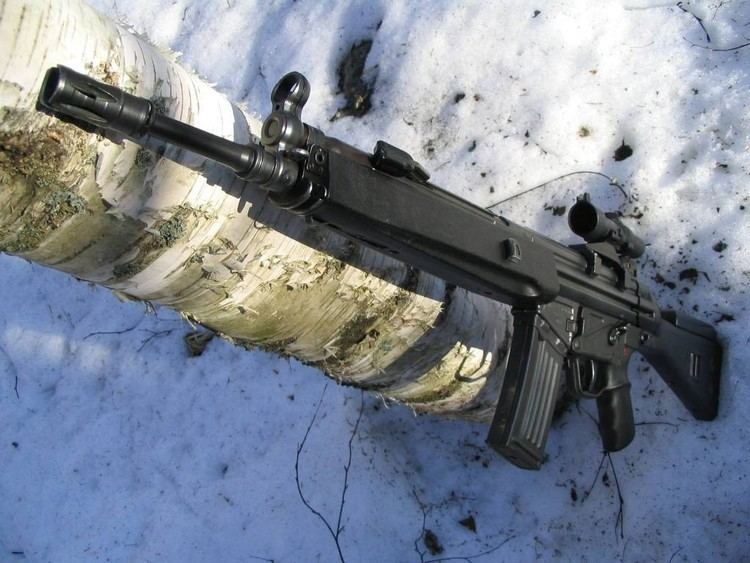In service 1968–present Produced 1968—2001 | Used by See Users | |
 | ||
Manufacturer Heckler & Koch, MAS (licensed), MKEK(licensed) | ||
The HK33 is a 5.56mm assault rifle developed in the 1960s by West German armament manufacturer Heckler & Koch GmbH (H&K), primarily for export.
Contents
Capitalizing on the success of their G3 design, the company developed a family of small arms (all using the G3 operating principle and basic design concept) consisting of four types of firearms: the first type, chambered in 7.62×51mm NATO, the second—using the Soviet 7.62×39mm M43 round, third—the intermediate 5.56×45mm caliber and the fourth type—chambered for the 9×19mm Parabellum pistol cartridge.
The HK33 series of rifles were adopted by the Brazilian Air Force (Força Aérea Brasileira or FAB), the armed forces of Thailand and Malaysia where they were produced under a license agreement. The rifle was also license-built in France by MAS and in Turkey by MKEK.
Operating mechanism
The HK33 is a selective fire weapon with Heckler & Koch's roller-delayed blowback system of operation. It employs a two-piece bolt consisting of a bolt head with a pair of rollers and bolt carrier. Upon firing, the two cylindrical rollers in the bolt head are cammed inward by inclined surfaces of the barrel extension and impart a rearward motion on the locking piece, which also propels the bolt carrier rearward. This built-in mechanical disadvantage delays the movement of the bolt head relative to the bolt carrier which is withdrawing at four times the velocity of the bolt. The rollers soon compress entirely into the bolt head, clearing the locking recesses of the barrel extension, and both parts now continue rearward together, opening the breech and actuating the extraction and feeding cycles. The chamber is opened under very high pressure, thus the chamber received a series of flutes in order to increase extraction reliability and prevent sticking of the spent casing to the chamber walls.
Features
The bolt also contains a spring extractor, an anti-bounce device (that prevents the bolt from being deflected after impacting the barrel breech) and a buffer. The ejector lever was installed in the trigger housing and is actuated by the recoiling bolt.
The HK33 has a conventional hammer-type firing mechanism. In the standard version, the rifle comes equipped with an ambidextrous trigger group with a selector lever that is simultaneously the weapon's safety (it has three positions: "S" or "0"—weapon is safe, "E"/"1"—semiautomatic fire, "F"/"25"—continuous fire). The "safe" setting mechanically disables the trigger. The trigger groups can be swapped out to meet the user's specific mission requirements. H&K offers several different trigger assemblies: a three-shot burst fire control group with selector lever/safety (selector settings: "0"—weapon is safe, "1"—single fire, "2"—2-round burst or "3"—burst, 3-rounds; the selector lever is ambidextrous); a "Navy" trigger unit (three settings: safe, semi and full auto fire) and a four-position trigger group (selector settings: safe, single fire, 3-round burst and automatic fire).
The rifle is fed from 25-round steel magazines weighing 250 g or 40-round aluminum magazines (weighing 157 g). 30-round arch magazines were also introduced for use with the rifle.
The barrel is equipped with a slotted flash suppressor that enables the use of rifle grenades and supports a standard G3-type bayonet that mounts above the barrel.
During its production life the rifle received several minor improvements (these modified weapons are sometimes referred to collectively as the HK33E). The fixed stock was strengthened and the synthetic forearm replaced with a handguard that allows a lightweight bipod to be attached and stowed into two grooves at the base. The shoulder pad in rifles fitted with a telescopic stock was changed to a concave type used thus far in the MP5 series. Initially the rifle was produced with a 305 mm (1:12 in) twist rate barrel, which was later upgraded to the faster 178 mm (1:7 in) twist rate (used to stabilize new, heavier NATO-standard SS109/M855 ammunition).
The rifle is disassembled into the following components for maintenance: the receiver, stock with return spring, bolt assembly and trigger pack with pistol grip.
Sights
The weapon is aimed using adjustable iron sights with a rotating rear drum (corrected mechanically for windage and elevation) that contains an open square notch used for immediate firing at 100 m and three apertures for 200, 300 and 400 m. The receiver top cover has a series of notches designed to accept a clamping mount (standard with the HK33, G3, G3SG/1 and MP5) for use with optical sights (typically the Hensoldt 4×24 scope) or a night vision device.
Accessories
Included with the rifle are a detachable bipod, bayonet (from the G3), sling, cleaning kit and a magazine loader. Additionally, the HK33 can be used to mount a 40 mm under-barrel HK79 grenade launcher or a blank-firing adaptor.
Variants
Sporting variants
Heckler & Koch also manufactured a semi-automatic only variant of the HK33A2 for the civilian shooting market designated the HK93A2 Also available in a retractable stock version with the designation HK93A3.
